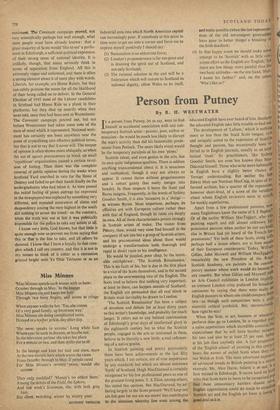Person from Putney
By R. H. WESTWATER Itz a person from Putney, let us say, were to find himself in accidental association with any con- temporary Scottish artist—painter, poet, author or musician—he would be much less likely to disrupt the man's activity than did his lamentable prede- cessor from Porlock. The more likely event would be the temporary paralysis of his own 'ploys.'
Scottish talent, and even genius in the arts, has its own quite indigenous qualities. There is seldom anything transcendental about it. It is tenacious and methodical, though it may not always so appear. It cannot thrive without gregariousness and a robust gaiety that easily merges into bawdry. In these respects it bears the Scott and Burns insignia. Frequently, in the words of Sydney Goodsir Smith, it is also 'excessive in a' things'—• as witness Byron. Most important, perhaps, its affinities are with European culture rather than with that of England, though its roots are deeply its own. AU of these characteristics persist strongly in Scottish artists of today. The visitor from Putney, then, would very soon find himself in the company of not One but a group of Scottish artists; and his preconceived ideas about them would undergo a transformation both thorough and rapid in direct ratio to his intelligence.
He would be puzzled, poor chap, by the inevit- able catchphrase 'The Scottish Renaissance.' This is no fault of his, but is due in the first place to a vice of the Scots themselves, and in the second place to the overweening vice of the English. The Scots tend to believe that nothing very important, at least to them, can happen outside of Scotland; the English are persuaded that all real talent in Britain must inevitably be drawn to London.
'The Scottish Renaissance' has been a subject of devotion and debate for at least thirty years to this writer's knowledge, and probably for much longer. It refers not to any belated continuation of Edinburgh's great days of intellectual glory in the eighteenth century but to what the Scottish people, engaged in the arts or interested in them, believe to be literally a new birth; a real reflower- ing of a native genius.
In Scottish painting and poetry particularly there have been achievements in the last fifty years which, I am certain, are of true importance by any standards but which are almost unknown lurth' of Scotland. Hugh MacDiarmid is certainly recognised by his few professional peers as one of the greatest living poets. T. S. Eliot, among others, has stated this opinion. But MacDiarmid, by ad hering largely to the Scots proverb 'We'll keep oor am n fish-guts for oor am n sea-maws' has contributed to the situation whereby few even among the educated English have ever heard of him. Similarly the educated English take little trouble to find out.
The development of 'Lallans,' which is nothing more or less than the braid Scots 'tongue, rich and uniquely suited to the expression of Scottish thought and passion, has occasionally been re- ferred to in English journals, usually as an intel- lectual 'stunt.' Its practitioners, like SydneY Goodsir Smith, are even less known than Mac- Diarmid himself. Those who write more habituallY in English have a slightly better chance of 'foreign' understanding. But neither the late Edwin Muir nor Norman MacCaig, in spite of iP formed acclaim, has a quarter of the reputation. however short-lived, of a score of the versifiers about whom English reviewers seem to search for weekly superlatives.
Apart from a few professional painters, how many Englishmen know the name of S. J. Pep1007 Or of the earlier William MacTaggart, who Os painting superb and still almost unknown MI- pressionist pictures when neither he nor anyboa else in Britain had yet heard of the French lily' pressionists? Yet both of these Scots, along with perhaps half a dozen others, are at least equals of their European counterparts: Today, Williain Gillies, John Maxwell and William MacTaggart' remarkably the new President of the Royal Scottish Academy, are painters in the content- porary manner whose work would do honour t° any country. But when Gillies and Maxwell 1108 an Arts Council exhibition in London recentlY' an eminent London critic prefaced his broadcast comments by saying that there were really n° English painters to whom one could compare dies° i two—as though such comparison were a quite f' essential critical yardstick. But. unconsciouslY' how right he was! When the Scot, in art, business or whatever, perforce does go to London, he is regarded with a naive superstition which incredibly contains the expectations that he will have heather between his toes and also be at least 25 per cent. better at his job than anybody else. A fair proportion of the 'English school' of painting in this centurY bears the names of exiled Scots when they are, not Welsh or Irish. The most advertised expone1! of advanced trends in British painting is a recent example. Mr. Alan Davie, believe it or not, iS Scot trained in Edinburgh. It seems hard on boll; sides that Scots have to leave to be recognisedanc that these unnecessary barriers should Otis English appreciation could do much to stirnular Scottish art and the English art lover is losirtgli Pod deal as it is.














































 Previous page
Previous page